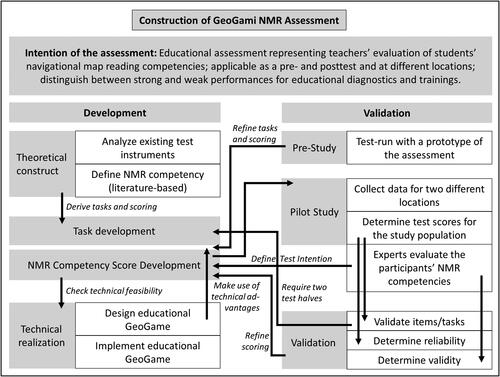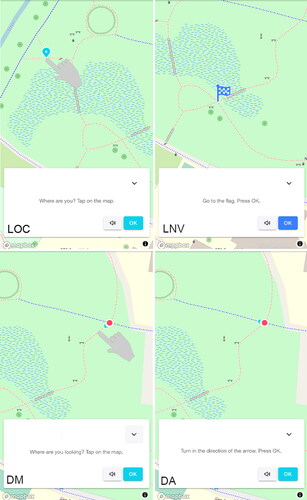Figures & data
Figure 1. Design framework for the GeoGami NMR Assessment construction. The assessment development and evaluation are closely interlinked and are to be understood as iterative processes. The intention of the assessment determined the decisions on methods for the development and validation of the instrument.

Figure 2. Self-location (LOC), navigation-to-a-flag (LNV), mark-view-direction (DM) and adopt-view-direction (DA) tasks in the GeoGami NMR assessment (location A) as displayed on the tablet screen. The hand is representing the participant’s tapping on the tablet screen © GeoGami.

Table 1. Accuracy and process data on each task type in the GeoGami Navigational Map Reading assessment.
Table 2. Thresholds defining different point categories for defining correct/incorrect confident/inconfident solutions in the GeoGami NMR assessment.Table Footnote1
Table 3. Item difficulties for each task ranging from 23 for the hardest task to 93 for the easiest task. Based on the item difficulty indices and the task types, the GeoGami NMR assessment was divided into test halves with similar tasks (task twins) in each test half.Table Footnote1
Table 4. Item-total correlations within the group of location tasks and the group of direction tasks of the GeoGami NMR assessment.Table Footnote1
Table 5. NMR competency score distribution in our GeoGami NMR assessment study.
Table 6. The split-half reliabilityTable Footnote1 for both locations of the GeoGami NMR assessment, exceeding the Cronbach’s Alpha in most of the cases.
Table 7. Correlations coefficients for NMR competency score of the GeoGami NMR assessment and scoring of the expert judgements.1 The correlations are higher when process data is included.
Table 8. Sensitivity analysis: thresholds and their effect on the GeoGami NMR assessment validation.Table Footnote1 The five examples in the table show small increases and decreases in reliability and validity, but overall a consistently high value for reliability and validity.
